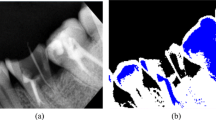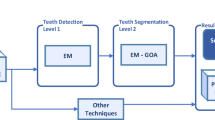Abstract
Dental periapical X-ray image (DXRI) segmentation is an important process to examine dental images towards diagnosing medical systems is an essential operation within practical dentistry for periodontitis recognition. However, traditional clustering algorithms in image processing frequently accept deficiencies in finding teeth sample boundaries and parameters. The presentation related to clustering is improved while further data produced with the user. In DXRI segmentation, semi supervised fuzzy clustering which is a new collective scheme. Initially, pre-processing is done for the input X-Ray image in order to minimize error. Specifically, Otsu’s method divide the dental X-Ray image into background and foreground regions. Here, the chosen FCM to separate the teeth regions commencing on the preceding steps. A Semi-supervised Hyperbolic Tangent Gaussian kernel Fuzzy C-Means algorithm (HTGkFCM) is preferred so as to increase an outcome that is optimum than compared to the traditional methods. So, current method is less sensitive to noise with robustness. Real datasets for the implementation on the proposed framework with cluster validity computation such as, Davies–Bouldin (DB), Segmentation Accuracy (SA), Simplified Silhouete Width Criterion (SSWC), processing time, PBM and Mean Absolute Error (MAE). So the proposed work has been enhanced in terms of 7%, 2%, 5%, 6%, 3% and 30% than the state-of-the-art works. Simulation outcome shows the quality of clustering in the framework have higher accuracy and more reliable than other clustering methods.








Similar content being viewed by others
References
Ahmad AS (2010) The effect of sharp contrast-limited adaptive histogram equalization (SCLAHE) on intra-oral dental radiograph images. Biomedical Engineering and Sciences (IECBES), IEEE EMBS Conference on, IEEE 400-405
Ahmad, Bt SA, Taib MN, Elaiza AN, Khalid, Taib H (2015) Variations of Adaptive Histogram Equalization (AHE) analysis on intra-oral dental radiograph. IEEE 6th Control and System Graduate Research Colloquium (ICSGRC) IEEE 87-92
Ali M, Khan M, Tung NT (2018) Segmentation of dental X-ray images in medical imaging using neutrosophic orthogonal matrices. Expert Syst Appl 91:434–441
Aoki EM, Abdala-Júnior R, Oliveira JXD, Arita ES, Cortes AR (2015) Reliability and reproducibility of manual and automated volumetric measurements of Periapical lesions. J Endod 41(9):1555–1559
Baldwin D, Göktaş Ü, Hereman W (2004) Symbolic computation of hyperbolic tangent solutions for nonlinear differential–difference equations. Comput Phys Commun 162(3):203–217
Barone S, Paoli A, Razionale AV (2015) Geometrical modeling of complete dental shapes by using panoramic X-ray, digital mouth data and anatomical templates. Comput Med Imaging Graph 43:112–121
Barton DJ, Clark SJ, Eleazer PD, Scheetz JP, Farman AG (2003) Tuned-aperture computed tomography versus parallax analogy and digital radiographic images in detecting second mesiobuccal canals in maxillary first molars. Oral Surg Oral Med Oral Pathol Oral Radiol Endod 96(2):223–238
Bezdek JC, Ehrlich R (1984) Full W the fuzzy c-means clustering algorithm. Comput Geosci 10(2):191–203
Bhatia A, Mago V, Singh R (2014) Use of soft computing techniques in medical decision making: A survey, Advances in Computing, Communications and Informatics (ICACCI, 2014 International Conference on, IEEE
Dael M, Lebotsa S, Herremans E, Verboven P, Sijbers J, Opara UL, Cronje PJ, Nicolaï BM (2016) A segmentation and classification algorithm for online detection of internal disorders in citrus using X-ray radiographs. Elsevier. Postharvest Biol Technol 112:205–214
Davies DL, Bouldin DW (1979) A cluster separation measure. IEEE Trans Pattern Anal Mach Intell 1:224–227
Deng H, Fitts JP, Peters CA (2016) Quantifying fracture geometry with X-ray tomography: Technique of Iterative Local Thresholding (TILT) for 3D image segmentation, Springer. Computational Geosciences 1-14
Grira N, Crucianu M, Boujemaa N (2008) Active semi-supervised fuzzy clustering. Pattern Recogn 41(5):1834–1844
Gumus E (2016) Segmentation and root localization for analysis of dental radiographs, Signal, Image and Video Processing 1-7
He K, Sun J, Tang X (2013 Jun) Guided image filtering. IEEE Trans Pattern Anal Mach Intell 35(6):1397–1409
Huang CC, Lee BS (2015) Diagnosis of vertical root fracture in endodontically treated teeth using computed tomography. J Dental Sci 10(3):227–232
Kaufman L, Rousseeuw P (1990) Finding Groups in Data, Wiley
Lin PL, Huang PY, Huang PW (2012) An automatic lesion detection method for dental X-ray images by segmentation using variational level set. Int Conf Mach Learn Cybern 5:1821–1825
Ludlow J, Mol A (2011) Image-receptor performance, a comparison of trophy RVG UI sensor and Kodak Ekta speed plus film, Oral surgery, Oral medicine, Oral pathology. Oral Radiology and Endodontology 91(1):109–119
Matsuda Y, Hanazawa T, Seki K, Araki K, Okano T (2002) Comparison between RVG UI sensor and Kodak insight film for detection of incipient proximal caries. Oral Radiol 18(2):41–47
Oishila Bandyopadhyay BA, Bhattacharya BB (2016) Long-bone fracture detection in digital X-ray images based on digital-geometric techniques, Elsevier. Comput Methods Prog Biomed 123:2–14
Pakhira MK, Bandyopadhyay S, Maulik U (2004) Validity index for crisp and fuzzy clusters. Pattern Recogn 37:487–501
puram K, Raghu FH, Nasraoui O (2011) Fuzzy and possibilistic shell clustering algorithms and their application to boundary detection and surface approximation. IEEE Trans Fuzzy Syst 3(1):29–43
Rad AE, Rahim MS, Norouzi A (2014) Level set and morphological operation techniques in application of dental image segmentation, World Academy of Science, Engineering and Technology. Int J Medical, Health, Biomed, Bioeng Pharmaceu Eng 8(4):182–185
Rodrigues ÉO, Morais FFC, Morais NAOS, Conci LS, Neto LV, Conci A (2016) A novel approach for the automated segmentation and volume quantification of cardiac fats on computed tomography. Comput Methods Prog Biomed 123:109–128
Rousseeuw PJ Silhouettes (1987) a graphical aid to the interpretation and validation of cluster analysis. J Comput Appl Math 20:53–65
Shah S, Abaza A, Ross A, Ammar H (2006) Automatic tooth segmentation using active contour without edges, Biometrics Symposium: Special Session on Research at the Biometric Consortium Conference, IEEE 1-6
Stokbro K, Aagaard E, Torkov P, Bell RB, Thygesen T (2016) Surgical accuracy of three-dimensional virtual planning: a pilot study of bimaxillary orthognathic procedures including maxillary segmentation. Elsevier. Int J Oral Maxillofac Surg 45(1):8–18
Tuan TM (2016) A cooperative semi-supervised fuzzy clustering framework for dental X-ray image segmentation. Expert Syst Appl 46:380–393
Wang Y-M (2015) Evaluation of location and dimensions of mandibular lingual canals, a cone beam computed tomography study. Int J Oral Maxillofac Surg 9:1197–1203
Yang MS, Tsai HS (2008) A Gaussian kernel-based fuzzy c-means algorithm with a spatial bias correction. Pattern Recogn Lett 29(12):1713–1725
Yasunori E, Yukihiro H, Makito Y, Sadaaki M (2009) On semi-supervised fuzzy c-means clustering. IEEE, InFuzzy Systems, IEEE International Conference. 1119-1124
Yin X, Shu T, Huang Q (2012) Semi-supervised fuzzy clustering with metric learning and entropy regularization. Knowl-Based Syst 35:304–311
Zhang DQ, Chen SC (2004) A novel kernelized fuzzy c-means algorithm with application in medical image segmentation. Artif Intell Med 32(1):37–50
Zhang J, Hu J (2008) Image segmentation based on 2D Otsu method with histogram analysis, Computer Science and Software Engineering, IEEE 6
Zhao M, Ma L, Tan W, Nie D (2006) Interactive tooth segmentation of dental models. IEEE Engineering in Medicine and Biology 27th Annual Conference 654-657
Zhou C (2015) A method of two-dimensional Otsu image threshold segmentation based on improved firefly algorithm, Cyber Technology in Automation, Control, and Intelligent Systems (CYBER). International Conference on, IEEE
Author information
Authors and Affiliations
Corresponding author
Ethics declarations
Conflict of interest
Anuj Kumar, H. S. Bhadauria, Annapurna Singh, state that there are no conflicts of interest. Patients’ rights and animal protection statements: This research article does not contain any studies with human or animal subjects.
Additional information
Publisher’s note
Springer Nature remains neutral with regard to jurisdictional claims in published maps and institutional affiliations.
Rights and permissions
About this article
Cite this article
Kumar, A., Bhadauria, H.S. & Singh, A. Semi-supervised OTSU based hyperbolic tangent Gaussian kernel fuzzy C-mean clustering for dental radiographs segmentation. Multimed Tools Appl 79, 2745–2768 (2020). https://doi.org/10.1007/s11042-019-08268-8
Received:
Revised:
Accepted:
Published:
Issue Date:
DOI: https://doi.org/10.1007/s11042-019-08268-8




